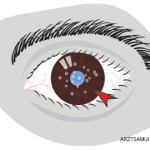
wavebreakmedia/shutterstock.com
Throughout their training and practice, physicians become adept at pattern recognition as a means to efficiently connect and synthesize seemingly disparate laboratory, physical exam, and radiologic and historical findings into a coherent theory for what likely ails the patient sitting in front of them. This inductive method of reasoning is necessary because, based on these conclusions, a physician will then choose from among a huge array of diagnostic tests to validate their clinical suspicions.
Frequently (and especially for inflammatory diseases), a panel of diagnostic tests will be required to evaluate each of the possible diagnoses being entertained. Judiciously pursuing the diagnostic workup helps minimize the risk of false-positive results that could lead to more invasive and risky testing and treatments.
The multi-organ inflammatory diseases evaluated and treated by rheumatologists and infectious disease doctors exemplify how challenging it can be to pursue a parsimonious diagnostic work-up. As a result, novel diagnostic testing strategies not only need to be more sensitive than existing tests, but they also need to more comprehensively query a patient sample for an array of possible etiologies to avoid missing diagnoses that may not fit existing diagnostic algorithms and clinical phenotypes.
Metagenomic deep sequencing (MDS) is an unbiased, hypothesis-free approach toward infectious disease diagnosis that leverages the remarkable efficiency of massively parallel sequencing technologies paired with concomitant advances in computational algorithms and processing speed that is required for the resulting large volumes of sequence data. As a consequence, it is now possible to sequence essentially all the nucleic acid in a given patient sample, filter out all the human sequences and then rapidly query large public databases to identify the source of the nonhuman sequences present in the sample.
Using this approach, one is able to look for essentially any type of pathogen (i.e., fungi, eukaryotes, DNA and RNA viruses, and bacteria) in a single test. Our group has previously shown that this technology can identify common and unusual infections in cerebrospinal fluid, blood, respiratory samples and stool from a wide range of species, including humans. In a recent study, we tested whether MDS was useful for identifying infections in the very small volumes of intraocular fluid obtained from patients with uveitis.
Uveitis
Less than 50% of all intraocular inflammatory diseases (e.g. uveitis) are associated with a systemic inflammatory disease, such as rheumatoid arthritis, vasculitis and inflammatory bowel disease. Numerous infectious causes of uveitis exist and can complicate diagnostic work-ups, especially if a patient has already been immunosuppressed for a systemic autoimmune disease. Specifically, it is sometimes unclear whether intraocular inflammation is a manifestation of a patient’s underlying condition or whether they have suffered an infectious complication as a result of their immunosuppressed state.
The relative inaccessibility of the intraocular compartments (i.e., anterior chamber and vitreous cavity) poses an obvious limitation to performing an extensive diagnostic work-up, as does the minute volumes of fluid that are available even if a diagnostic paracentesis is performed. Even the most advanced centers offer only a handful of microbiologic assays for intraocular fluid including culture (e.g., bacterial, acid fast bacilli, fungal and rarely viral) and pathogen-specific polymerase chain reactions (e.g., herpes simplex virus types 1 and 2, varicella zoster virus, cytomegalovirus, Toxoplasma gondii).
Not surprisingly, an etiologic agent is not identified in more than half of uveitis cases, and physicians are forced to make empiric treatment decisions. If local or systemic immunosuppression is pursued to treat a presumed autoimmune cause of uveitis, this can serve to exacerbate an undiagnosed intraocular infection.
We first used MDS in three uveitis cases in which a pathogen had already been identified and showed that MDS was consistent with the gold standard microbiologic testing for herpes-simplex virus type 1, Cryptococcus neoformans and Toxoplasma gondii.1
We also showed that in two noninfectious intraocular fluid samples, MDS did not detect any pathogenic organisms. Rather, the MDS results from these two samples largely reflected organisms that are found in laboratory reagents.
Case Study
After showing that MDS could be used to identify common infectious causes of uveitis, we turned to a patient with a 16-year course of chronic, idiopathic, asynchronous bilateral uveitis. In 1999, he noticed floaters and mild decreased vision in the left eye. The patient was seen by an ophthalmologist in Germany and found to have anterior uveitis, which is the most common uveitis entity.
A routine laboratory work-up (e.g., HLA-B27, RF, c-ANCA, hepatitis serology panel and PPD) was unrevealing. The patient’s intraocular inflammation was managed with topical steroids and non-steroidal anti-inflammatory drugs (NSAIDs) with minimal improvement.
Two years later, the patient had ocular symptoms in the right eye and was diagnosed with bilateral idiopathic anterior uveitis. RPR and repeat HLA-B27 were negative. At this time, he had already had cataract surgery in the left eye, likely due to a combination of topical steroid and uncontrolled intraocular inflammation. Seven years after disease onset, the patient was initiated on a potent topical steroid (Durezol or difluprednate). That failed to control his inflammation, so he was placed on systemic prednisone and methotrexate, in addition to frequent topical steroid drops.
He eventually developed a white cataract in the right eye and underwent cataract surgery and IOL placement. His immunosuppression was discontinued after one year due to treatment futility. There was a discussion to transition the patient to another antimetabolite, CellCept, but he never started the medication due to recurrent lower extremity rashes.
The patient relocated to San Francisco in 2012 and sought care at the Proctor Foundation at the University of California, San Francisco. His exam was notable for inflammatory cells in the anterior and vitreous cavity bilaterally. Further, he had heterochromia (different iris color between the two eyes) suggestive of chronic viral infection.
An anterior chamber paracentesis was performed, and aqueous fluid was tested for HSV, VZV and CMV by polymerase chain reaction (PCR). Although the results were negative for herpesvirus infection, the patient was maintained on systemic and intravitreal antivirals because of the high degree of clinical suspicion. When he had to undergo a pars plana vitrectomy to remove an epiretinal membrane in the left eye, another diagnostic work-up was initiated, which included cytology, bacterial and fungal cultures, HSV, VZV and CMV PCRs. Again, all tests were nondiagnostic.
The patient’s aqueous fluid was finally evaluated by unbiased MDS. After filtering out host sequencing reads and environmental reads, the most predominant remaining viral reads aligned to rubella virus, a known infectious cause of uveitis. More importantly, a near full-length genome (99.3%) of the rubella virus was obtained. Phylogenetic analysis revealed that the rubella virus detected in the patient’s eye was mostly closely related to a rubella virus isolated in Stuttgart, Germany, in 1992.
Upon further questioning, the patient reported that he had had a three-day fever and whole body rash in 1993 when he was living in Germany. Because of the German vaccination policies at the time, he had not been immunized against rubella virus. Thus, it appears as if his ocular history actually began in 1993, a full six years prior to the onset of his uveitis.
In this case, MDS not only identified a very unusual cause of infectious uveitis, it also highlighted the Achilles heel of pattern recognition as a primary means of diagnosis in patients with inflammatory disease. In the vast majority of cases, a patient’s three-day fever and rash that had occurred six years prior to the onset of their current clinical syndrome would not be considered clinically relevant—or even asked about by most clinicians. Thus, MDS has the ability to not only identify unusual pathogens, but it will also help redefine clinical syndromes by its unbiased and comprehensive approach.
Additional Evidence
This point has been vividly illustrated in two other patients who initially developed intraocular inflammation before developing more systemic illnesses.
In the case of an immunodeficient adolescent boy who presented with thrombocytopenia and asynchronous, bilateral uveitis, an autoimmune condition was suspected.2 This diagnostic impression later clouded the interpretation of his subsequent presentation with chronic meningoencephalitis months later.
MDS has the ability to not only identify unusual pathogens, but it will also help redefine clinical syndromes by its unbiased & comprehensive approach.
After an exhaustive infectious and autoimmune workup and clinical deterioration after continued immunosuppressive therapy, he was found to have neuroleptospirosis via MDS. In retrospect, the leptospirosis not only caused his meningoencephalitis, but it also likely caused his initial presentation of uveitis and thrombocytopenia (i.e., Weil syndrome) months earlier.
In addition, we used MDS to identify an unusual amoebic cause of meningoencephalitis (Balamuthia mandrillaris) in a patient who initially presented with acute monocular vision loss and endophthalmitis.3 The cause of the endophthalmitis was suspected to be bacterial or toxoplasmosis. However, after B. mandrillaris was identified, subsequent RT-PCR of the remaining intraocular fluid confirmed the first known case of intraocular B. mandrillaris infection.
Conclusion
It is good practice for clinicians to order diagnostic tests based on the patient’s clinical findings to optimize the positive predictive value. However, in cases for which conventional diagnostics have failed to elucidate a cause and the suspicion for an infection is high, then an unbiased approach is of critical importance. Expanded use of MDS in the clinical setting will serve to further redefine the full spectrum of infectious disease and, to the degree that the sensitivity of the test can be demonstrated, will help reassure clinicians that an infection is not present if the results of an MDS assay do not identify any infectious agents.
 Thuy Doan, MD, PhD, is an assistant professor for the Francis I. Proctor Foundation and the Department of Ophthalmology at the University of California San Francisco.
Thuy Doan, MD, PhD, is an assistant professor for the Francis I. Proctor Foundation and the Department of Ophthalmology at the University of California San Francisco.
 Michael R. Wilson, MD, MAS, is an assistant professor in the Department of Neurology at the University of California San Francisco.
Michael R. Wilson, MD, MAS, is an assistant professor in the Department of Neurology at the University of California San Francisco.
 Joseph L. DeRisi, PhD, is a professor in the Department of Biochemistry and Biophysics at the University of California San Francisco and co-president of the Chan Zuckerberg Biohub in San Francisco.
Joseph L. DeRisi, PhD, is a professor in the Department of Biochemistry and Biophysics at the University of California San Francisco and co-president of the Chan Zuckerberg Biohub in San Francisco.
References
- Doan T, Wilson MR, Crawford ED, et al. Illuminating uveitis: Metagenomic deep sequencing identifies common and rare pathogens. Genome Med. 2016Aug 25;8(1):90. Erratum in: Genome Med. 2016 Nov 22;8(1):123.
- Wilson MR, Naccache SN, Samayoa E, et al. Actionable diagnosis of neuroleptospirosis by next-generation sequencing. N Engl J Med. 2014 Jun 19;370(25):2408–2417.
- Wilson MR, Shanbhag NM, Reid MJ, et al. Diagnosing balamuthia mandrillaris encephalitis with metagenomic deep sequencing. Ann Neurol. 2015 Nov;78(5):722–730.


